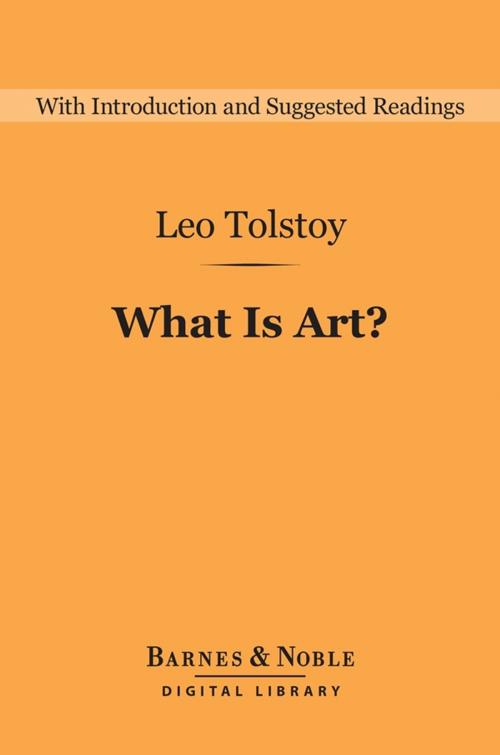What Is Art? (Barnes & Noble Digital Library)
Nonfiction, Religion & Spirituality, Philosophy, Aesthetics| Author: | Leo Tolstoy | ISBN: | 9781411467491 |
| Publisher: | Barnes & Noble | Publication: | March 13, 2012 |
| Imprint: | Barnes & Noble | Language: | English |
| Author: | Leo Tolstoy |
| ISBN: | 9781411467491 |
| Publisher: | Barnes & Noble |
| Publication: | March 13, 2012 |
| Imprint: | Barnes & Noble |
| Language: | English |
This edition includes a modern introduction and a list of suggested further reading.
What Is Art? is the result of fifteen years of reflection about the nature and purpose of art. The book is noteworthy not only for its famous iconoclasm and compelling attacks on the aestheticist notion of "art for art's sake," but even more for its wit, its lucid and beautiful prose, and its sincere expression of the deepest social conscience.
Tolstoy's challenging claims that all good art is related to the authentic life of the broader community and that the aesthetic value of a work of art is not independent of its moral content deserve the most serious attention by contemporary artists and aestheticians. Most of all, a sustained consideration of the cultural import of art by someone who himself was an artist of the highest stature--Tolstoy is an author critics typically rank alongside Shakespeare and Homer--will always remain relevant and fascinating to anyone interested in the place of art and literature in society.
Tolstoy's challenging claims that all good art is related to the authentic life of the broader community and that the aesthetic value of a work of art is not independent of its moral content deserve the most serious attention by contemporary artists and aestheticians. Most of all, a sustained consideration of the cultural import of art by someone who himself was an artist of the highest stature--Tolstoy is an author critics typically rank alongside Shakespeare and Homer--will always remain relevant and fascinating to anyone interested in the place of art and literature in society.
This edition includes a modern introduction and a list of suggested further reading.
What Is Art? is the result of fifteen years of reflection about the nature and purpose of art. The book is noteworthy not only for its famous iconoclasm and compelling attacks on the aestheticist notion of "art for art's sake," but even more for its wit, its lucid and beautiful prose, and its sincere expression of the deepest social conscience.
Tolstoy's challenging claims that all good art is related to the authentic life of the broader community and that the aesthetic value of a work of art is not independent of its moral content deserve the most serious attention by contemporary artists and aestheticians. Most of all, a sustained consideration of the cultural import of art by someone who himself was an artist of the highest stature--Tolstoy is an author critics typically rank alongside Shakespeare and Homer--will always remain relevant and fascinating to anyone interested in the place of art and literature in society.
Tolstoy's challenging claims that all good art is related to the authentic life of the broader community and that the aesthetic value of a work of art is not independent of its moral content deserve the most serious attention by contemporary artists and aestheticians. Most of all, a sustained consideration of the cultural import of art by someone who himself was an artist of the highest stature--Tolstoy is an author critics typically rank alongside Shakespeare and Homer--will always remain relevant and fascinating to anyone interested in the place of art and literature in society.















